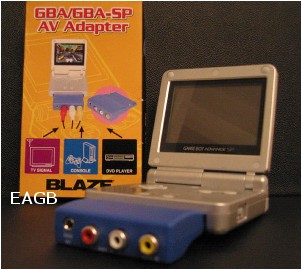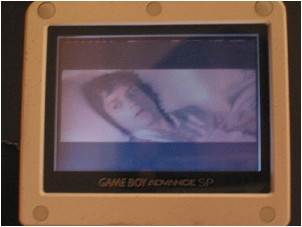Review
- GBA/GBA
SP AV Adapter
(Added
22nd July 2003)
Introduction
The GBA/GBA SP AV Adapter is a new 3rd party accessory
that effectively transforms your GBA into an external
Audio/Video monitor. It has standard RCA inputs for
both audio and video and is thus compatible with any
AV device that has an AV-Out option.

Full
view of the AV Adapter
inside a GBA SP.
Brief Feature List
- Specially designed for GBA/GBA SP console.
-
Compatible with various DVD, VCD & Video Game systems.
-
Digital menu system controlled by the GBA buttons.
-
Stereo Audio Ports, Video Port & Headphone Jack
Out.
- Easy Installation
What's In The box?
The only thing that was in the box was the Adapter
itself. There weren't any instruction manuals or even
a simple leaflet to get you started. This isn't good,
because as I discovered later, the Adapter has some
extra features that really needs to be documented. Hopefully,
mine was just a review set, and not the final shipping
product. Don't worry though, I'll explain about the
other functions later on in my review.
Installation
Installation was a breeze and even my technologically
illiterate grandparents could do it without a manual.
To give you a better picture, however, here's my installation
procedure in list form.
1. Remove whatever game cartridge you have in the
GBA.
2. Insert the Adapter into the cartridge slot
of the GBA.
3. Plug in one end of the AV cable (which
is not included) into the AV-Out ports of your device.
4.
Plug in the other end of the AV cable into the Adapter.
(Note: Most AV devices follow the standard color coding
where Yellow is for the video signal and Red and White
for sound. Make sure you don't mix them up.)
5. Plug
in you headphones in to the "headphone jack"
on the Adapter.
6. Turn on your AV device and then
turn on your GBA.
7. If the cables are properly inserted,
you should be able to see the video on the GBA's
screen and hear the sound through your headphones.

Hooked
up to a NGC.
Resident Evil Zero on screen.
Using The Tuner
As you can see, the installation was extremely simple
and using it isn't much tougher. Once everything is
plugged in correctly and you turn on the GBA, you'll
see the usual "GameBoy" flash screen on your
display, followed by the video of whatever device you've
plugged into the adapter.
Like I said, I didn't like the fact that the Adapter
arrived without an instruction manual. Although it works
the moment you plug it in, you would never know that
it actually had functions to adjust the video display,
unless of course like me, you pressed every button and
combinations of just to see what would happen.
Anyway, here is the list of functions that I've discovered.
- Button "A" will take you forward through
the options, and "B" goes backwards.
-Shoulder
button "L" and "R" respectively
adjusts the current option chosen. As default, it controls
the volume level (Note: the GBA volume control is not
used).
- Button "Select" will refresh the
screen, which I believe is for trouble-shooting picture
issues, although I encountered none while using the
Adapter.
- Button "Start" and the D-Pad
do nothing.
The options that you can adjust are Brightness, Contrast,
Hue and Saturation which I found very impressive as
it allowed me to tweak the displayed video exactly to
my liking. On its own, the picture quality was pretty
respectable, considering the fact that GBA resolution
is about one-fourth of a regular TV screen. Audio playback
requires you to use headphones plugged in to the headphone
jack provided on the adapter. It would have been perfect
if they could have made the sound play through the GBA's
onboard speakers, or like the TV Tuner, include a small
speaker on the Adapter itself.

PS2
: Ratchet & Clank.
What Could You Do With It?
For those of you who are now thinking of getting
the Adapter, here is a few of my own suggestions on
what you could do with it.
1) The Nintendo GameCube has a battery pack that
you can buy. With this in mind, you could use the Adapter
and your GBA as a monitor for your new "trans-portable"
GameCube. Cool!
2) Buy one of those combo CD/VCD discmans and hook
it up to the Adapter and your GBA. Now you can watch
a movie on the train or on the bus instead of just listening
to music. Cool!
3) If your parents won't let you watch VCD/DVD's
past your bedtime, buy a really long AV cable then hook
it up to the player and the Adapter on your GBA. Find
a way to disguise the wires and run it all the way to
your bed. Now, when your parents tell you to turn off
the TV and go to bed, you can hide under the covers
and continue watching your movies with the headset on.
Cool! (If you get caught, please don't tell them how
you got the idea to do this.)

Family
Guy DVD.
Conclusion
The Adapter is really a fun gadget and although not
as feature rich as the TV Tuner, is really quite useful
if you need an external monitor in a hurry. Thanks to
Nintendo, the GBA's display is more than up to the task,
and its high resolution can handle nearly any kind of
video input from DVDs to home consoles. Remember, however,
that unlike the GBA SP, the regular GBA doesn't have
a front light, so if you use the Adapter on the GBA,
you will have problems viewing the screen in dark or
low-light conditions.
Anyway, my only request for future releases, or updates
to this great piece of hardware, is for external speaker
support and most importantly, a detailed instruction
manual. Other than that, the Adapter is certainly a
great product, and something that GBA gadget lovers
would definitely like.

Lord
of the Rings DVD (widescreen).

Premier
League Football via Digital Cable Box.
** I would like to apologize
for the quality of the pictures and assure you that
it does not reflect the true quality of the video displayed
by the Adapter - which, dependent on the source, is
pretty good. If the picture is blurred, it's probably
because I moved while taking the shots on extreme close
up.
|

